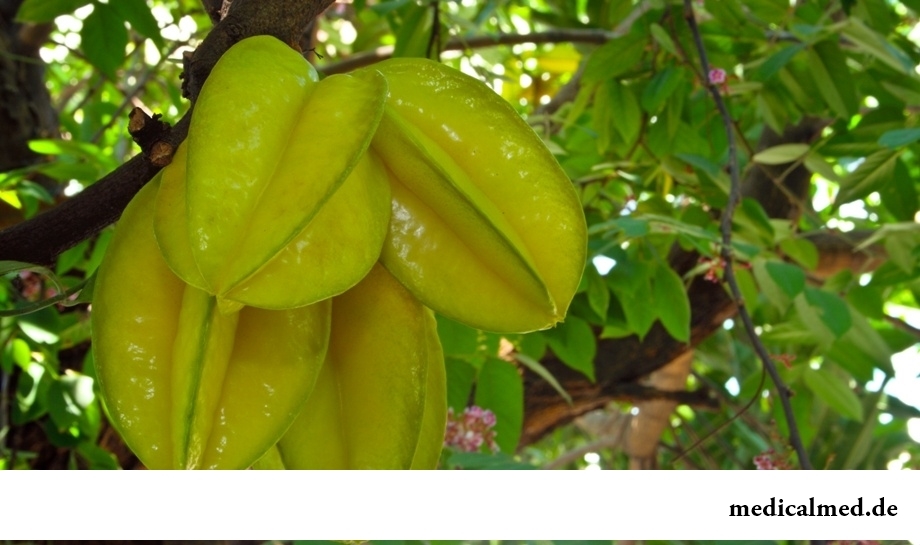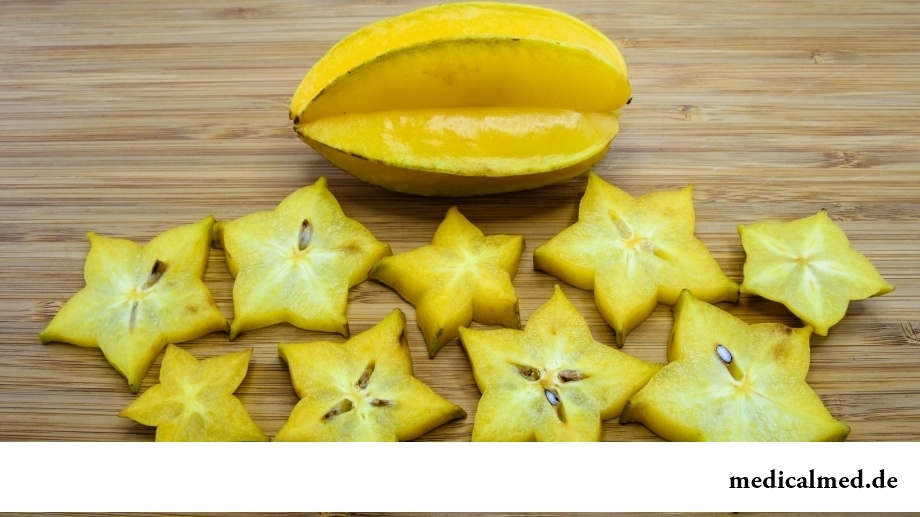





Carambola
The carambola represents a tropical tree from Kislichnye's family which has leaves of an akatsevidny form, dense krone and reaches up to 4-5 meters in height.

Biological features and distribution
The carambola is a hygrophilous tree which grows, generally in tropical climate of South America and East Asia. The tree gained the greatest distribution in Brazil, Sri Lanka, India, the USA, Ghana, Indonesia and Israel.
Fruits of a carambola have the form of a star and a yellowish shade. Pulp of fruits juicy, crackling can also have small ridge outgrowths which contain a large amount of vitamin C.
Mature fruits of a carambola have amber color and differ to taste, depending on versions. Five-pointed fruits have sweet-sour taste, and six-pointed with massive outgrowths – sweet smack.
Some grades of a carambola taste like apple, grapes and plum, and others are similar to a gooseberry and a lemon.
Useful properties of a carambola
Useful properties of a carambola are high, thanks to structure which is rich with phosphorus, iron, organic acids, calcium and potassium. Vitamins of group B and C, beta carotene, provitamins, ascorbic acid are a part of fruits.
In Ancient Asia in traditional medicine leaves and flowers of a carambola for treatment of various diseases were actively used.
Now in India this fruit is used as styptic means, and also ingredient for medical drugs against hemorrhoids, fever, diarrhea and a hungover syndrome.
The candied fruits of a carambola are anti-inflammatory, antiedematous and cholagogue drug.
In Brazil broth from fruits and leaves of this tree is used as antiemetic and anesthetic. The crushed leaves of a carambola apply to treatment depriving, smallpox and as helminthic.
As a result of scientific research as a part of roots and leaves of a tree the content of glyutaminovy acid which is effective antidote at intoxications was revealed.
Seeds of fruits of a carambola use as soothing and an antispasmodic at diseases of bodies of a GIT and bronchial asthma.
Useful properties of a carambola are directed to strengthening of protective functions of a human body, a lowering of arterial pressure, normalization of content of sugar in blood, and also effectively work against a headache and dizziness.
Caloric content
The carambola is low-calorie fruit in which 31 kcal. Also fruits contain 7 g of carbohydrates and 1 g of proteins.
Use of a carambola
The carambola has pleasant sourish and sweet taste and well satisfies thirst. In the different countries of the world this fruit is used for preparation of a set of dishes.
In Europe the carambola is used, generally for decoration of ice cream, cocktails and desserts. On Sri Lanka and in India the fruit is used in the raw together with a peel. China adds this fruit to fish dishes, and in Hawaii from it prepare a water-ice with addition of a lemon.
From a carambola good sauce for meat dishes to which add horse-radish, a celery, vinegar and spices turns out. Fruit gives to meat, vegetable and fish dishes unusual, but pleasant smack.
In the Southern Asia and America the unripe carambola is used as vegetable which is pickled and salted, and also used for preparation of ragout. And from the ripened fruits of fruit tasty purees, puddings, juice, jelly and fruit salads turn out.

Carambola contraindications
The carambola is contraindicated to the use to people with a serious illness of the alimentary system, including with gastritis, a peptic ulcer and a coloenteritis.
Fruit contains a large amount of oxalic acid and vitamin C which can provoke renal pathologies and disturbances of a salt metabolism.
With care the carambola should be used at individual intolerance of ascorbic acid and predisposition to allergic reactions.
The stomach of the person not bad copes with foreign objects and without medical intervention. It is known that the gastric juice is capable to dissolve even coins.

The Genetically Modified Organisms (GMO) are plants or animals (as a rule, agricultural) in whose genotype...
Section: Articles about health
Traveling all over the world, many try to try the most exotic dishes of national cuisines. There is even a so-called gastronomic tourism which, according to gourmets, not only allows to receive new feelings, but also is capable to show life the friend...
Section: Articles about health
For most of the working people the problem of having a snack is particularly acute enough. Sooner or later there is a question: what can be eaten quickly between a breakfast and a lunch or a lunch and leaving from service so that to receive necessary power feed, but not to overload an organism with harmful components or excess calories? We bring to your attention the list of products which quite conform to these requirements....
Section: Articles about health
Deciding to get rid of an addiction, not all imagine what effects it is necessary to face. Process of refusal from ку...
Section: Articles about health
The business lady, the become mother, it is necessary to solve an array of problems. But of them is main: how to combine the beloved child and work? What traps trap the working mother and how she needs to behave?...
Section: Slideshow
Today about 30 diseases, sexually transmitted are known. Wide circulation of these illnesses is extremely promoted by the dual attitude towards them: on the one hand, most of people know about "shameful" diseases very little and do not aim at receiving detailed and reliable information, considering that such problems personally will never concern them. With another – there are delusions about STD which instill unreasonable confidence that troubles such...
Section: Articles about health
Cellulitis - very widespread cosmetic shortcoming which arises approximately at 80% of women sooner or later. Emergence ег...
Section: Articles about health
Use of medicinal plants in therapy is urgent today, more than ever. The drugs made of curative herbs cannot replace completely modern synthetic drugs, but their use becomes frequent serious help in simplification a leak...
Section: Articles about health
Beauty shop – the place which is associated only with positive emotions: joy, pleasure, relaxation. However visit of salon where work with biological material of clients, not always harmlessly is conducted. Today more than 100 pathogenic microorganisms who can catch in beauty shop including deadly to health are known....
Section: Articles about health
The pine is one of the most widespread plants of our woods. Its needles and pitch not without reason called by "gallipot", since ancient times испол...
Section: Articles about health
Partial and the more so full loss of hearing significantly reduces quality of life. Difficulties with communication lead to loneliness and isolation. The person who badly hears experiences difficulties with social and professional implementation, quite often has problems in...
Section: Articles about health
All parents are ready to what the baby often and pisat much. Since then, as the absorbing diapers strongly became current, keeping of the kid in dryness does not represent any problems. But if the grown-up kid continues to urinate in panties, parents begin to feel concern – whether it is normal, or the kid has an urine incontience? Let's try to understand what is enuresis why it arises at children and at what age it is necessary to begin it to treat....
Section: Articles about health
Tea is loved and use almost everything. This drink has tonic properties, contains the tannins capable podavlit...
Section: Articles about health
Small appetite at the child – the complaint which pediatricians should hear practically from each mother. Most often it is carried to the category of children's whims, however the refusal of food in certain cases can be to alarming symptoms therefore it cannot be ignored....
Section: Articles about health
Visit of doctors – business not the most pleasant, and many people do not hurry to undergo necessary planned inspections. Such behavior is extremely thoughtless and improvident. Our health is necessary not only to us: wellbeing of darlings, children, grandsons and aged parents directly depends on as far as we are vigorous and able-bodied. Therefore in time to be inspected – a duty of any modern person. Specialists consider that 7 regular surveys and di are especially necessary for women...
Section: Articles about health
Health and attractiveness - eternal values, pursuing which people often use the most unusual ingredients and technicians...
Section: Articles about health
Wood louse – the ordinary-looking unpretentious plant extended in all territory of our country. It quickly expands, and sometimes fills sites, bringing a lot of chagrin to gardeners. Perhaps, they would be upset less if knew that the wood louse is the prices...
Section: Articles about health
Physical activity is necessary for normal functioning of a human body. At a lack of the movement joints cease to function, muscles atrophy, cardiovascular activity is broken and the metabolism worsens. The modern city rhythm of life does not provide the person with an adequate exercise stress, additional - sport is necessary. Tedious tasks the huge number of the people having those or ин exists sport not all to liking, but also...
Section: Articles about health
Statistically, pathologies of a thyroid gland in the world more than 500 million people have. Failures in work of this body conduct to is heavy...
Section: Articles about health
Within several decades of our compatriots convinced that the use of butter nasty affects a condition of coronary vessels. As a result the reputation of a product was impaired thoroughly a little, and many almost ceased to include...
Section: Articles about health
We present to yours the TOP of the medicamentous means exerting the stimulating impact on a potentiality, i.e. on ability of the man to commission of sexual intercourse. At once it is necessary to tell that not always disturbances of erectile function can be eliminated with reception of this or that drug. The reasons of decrease in a potentiality there can be a set, from banal overfatigue before tumoral process in a small basin therefore if the man faces similar problems too often, it should turn...
Section: Articles about health
Sugar - the digestible refined product which is not of special value for an organism of the modern person. Use...
Section: Articles about health
Any person who faced a disease knows that treatment costs expensive. It belongs also to consultations of qualified specialists, and to the diagnostic procedures which are not included in the list of obligatory medical services. Question of cost of medicinal Wednesday...
Section: Articles about health
For anybody not a secret that the modern person eats not as his ancestors. For the last 100 years in broad access there were absolutely new products which are result of use of the latest technologies in food production. Significantly ways of storage and transportation of food ingredients changed, and people of the whole world had an opportunity to regularly use those products about which their grandfathers and grandmothers did not even know....
Section: Articles about health
It would seem, to buy drugs in Moscow does not make a problem – a drugstore, and not one, is available for each resident of the capital in step a toast...
Section: Articles about health
Bees – really unique beings. Practically all products of their life activity are used by the person. Since the most ancient times medicinal properties of honey and other substances received in the course of beekeeping are known. The fact that all these пр is especially significant...
Section: Articles about health
History of mankind contains several tens of epidemics whose emergence was compared by eyewitnesses and historians to doomsday. The most terrible of them claimed the lives of millions of people, having made even the whole people to the person of the earth. What they − the diseases striking terror? Whether it managed to the person to find treatment, or he is still powerless before forces of nature?...
Section: Articles about health
